Abstract
The transformation of stimulus functions is said to occur when the functions of one stimulus alter or transform the functions of another stimulus in accordance with the derived relation between the two, without additional training. This effect has been demonstrated with a number of derived stimulus relations, behavioral functions, experimental preparations, and subject populations. The present paper reviews much of the existing research on the transformation of stimulus functions and outlines a number of important methodological and conceptual issues that warrant further attention. We conclude by advocating the adoption of the generic terminology of relational frame theory to describe both the derived transformation of stimulus functions and relational responding more generally.
Keywords: transfer and transformation of stimulus functions, derived stimulus relations, stimulus equivalence, relational frame theory, adults and children
Full text
PDF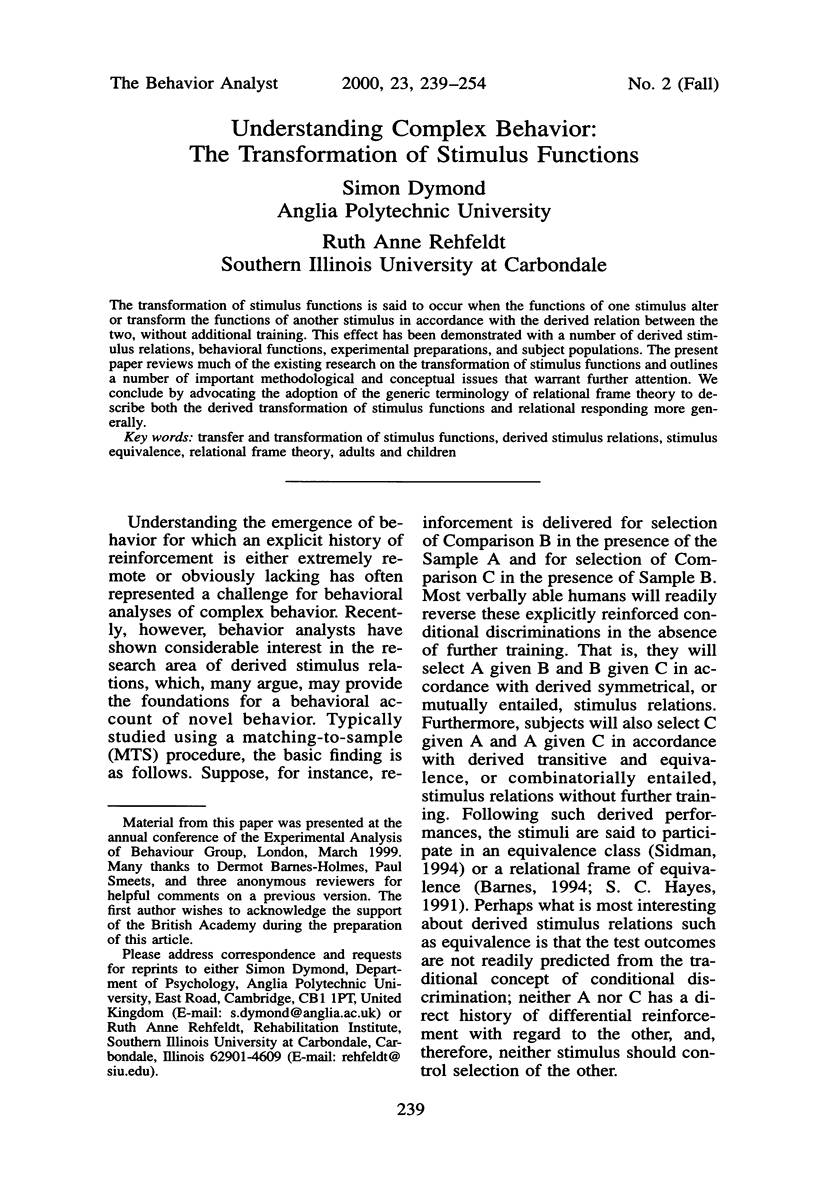
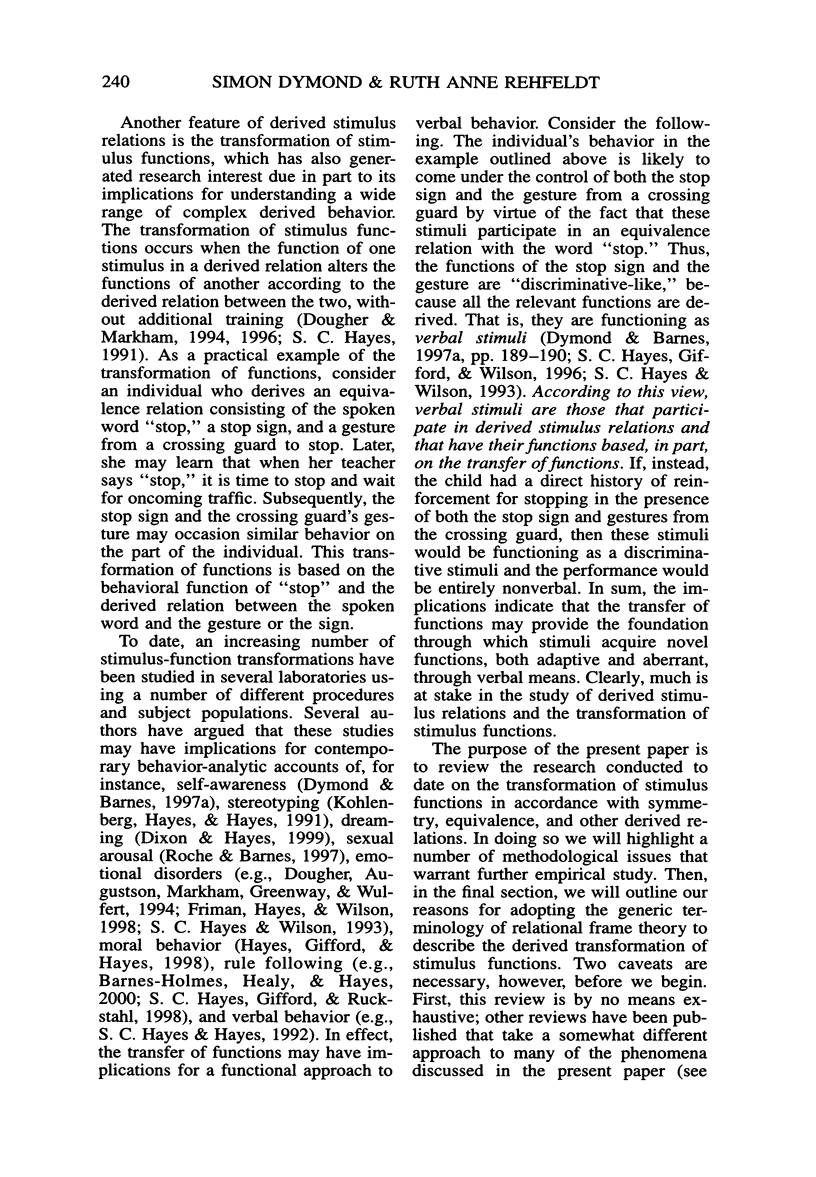


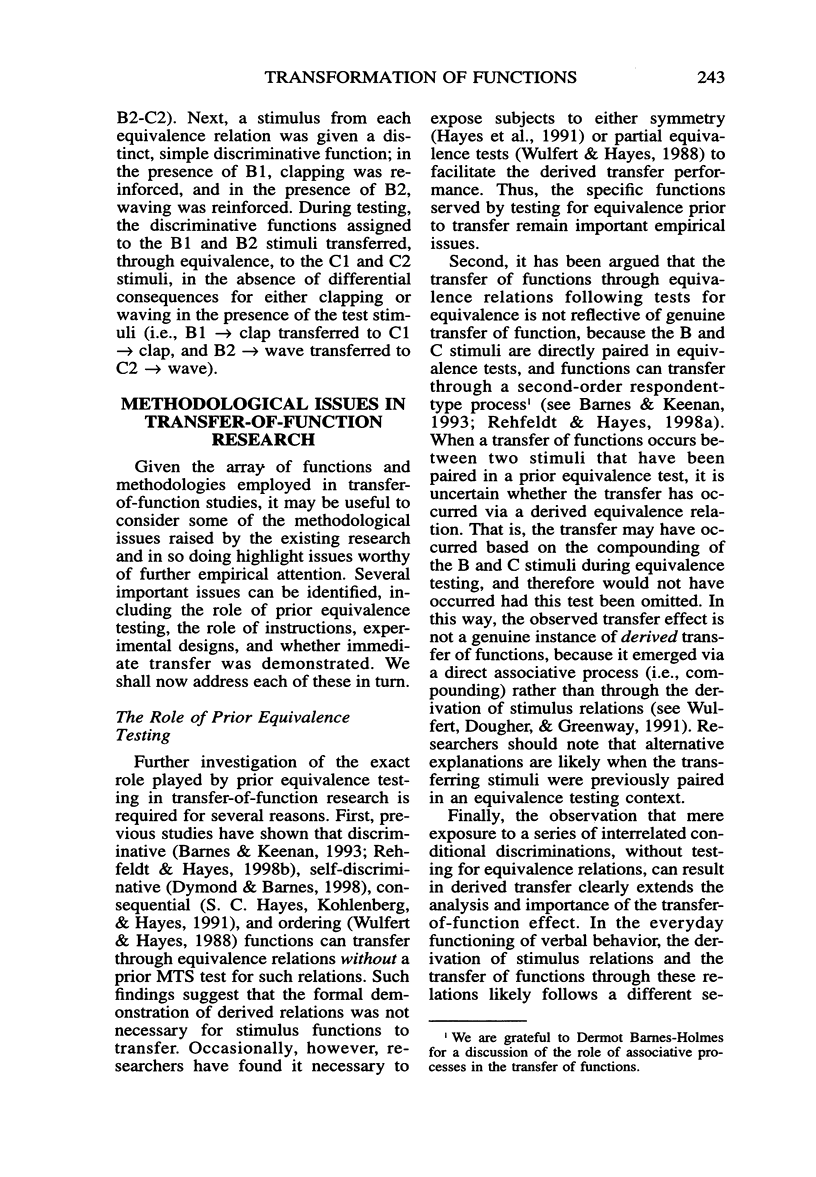

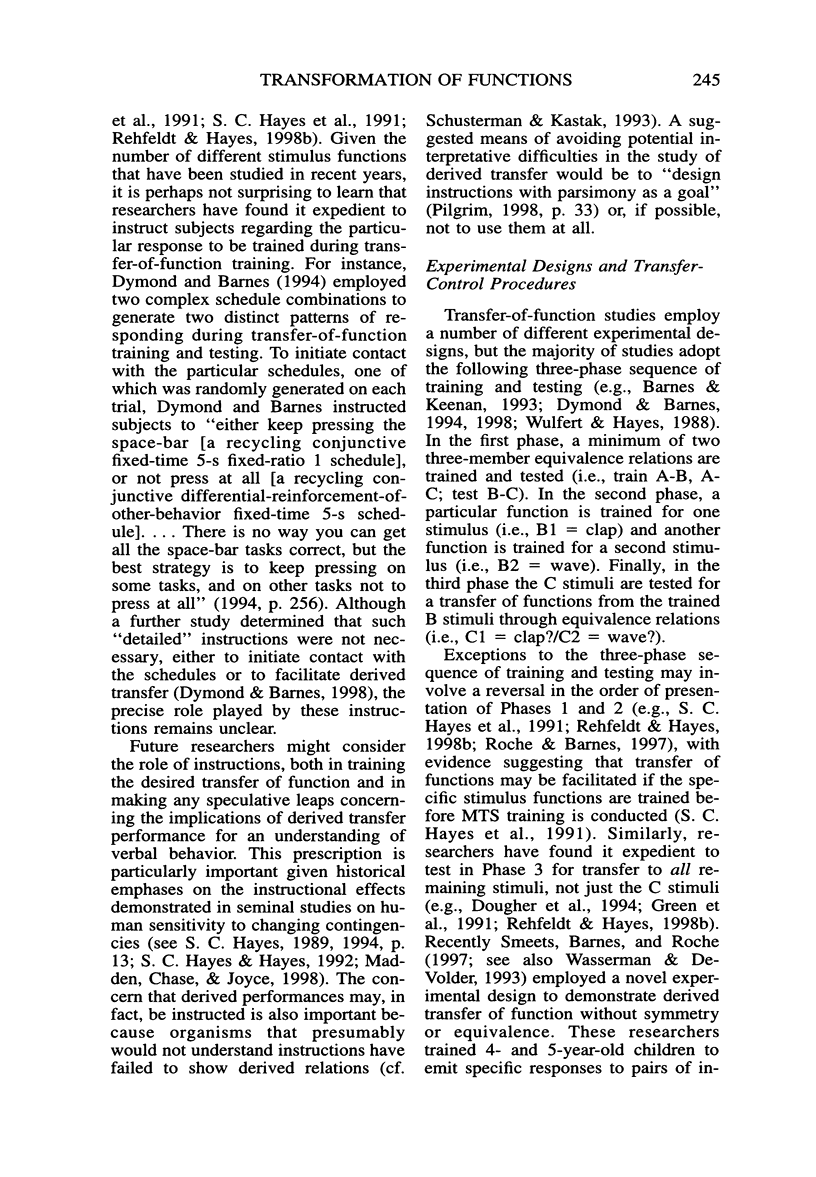
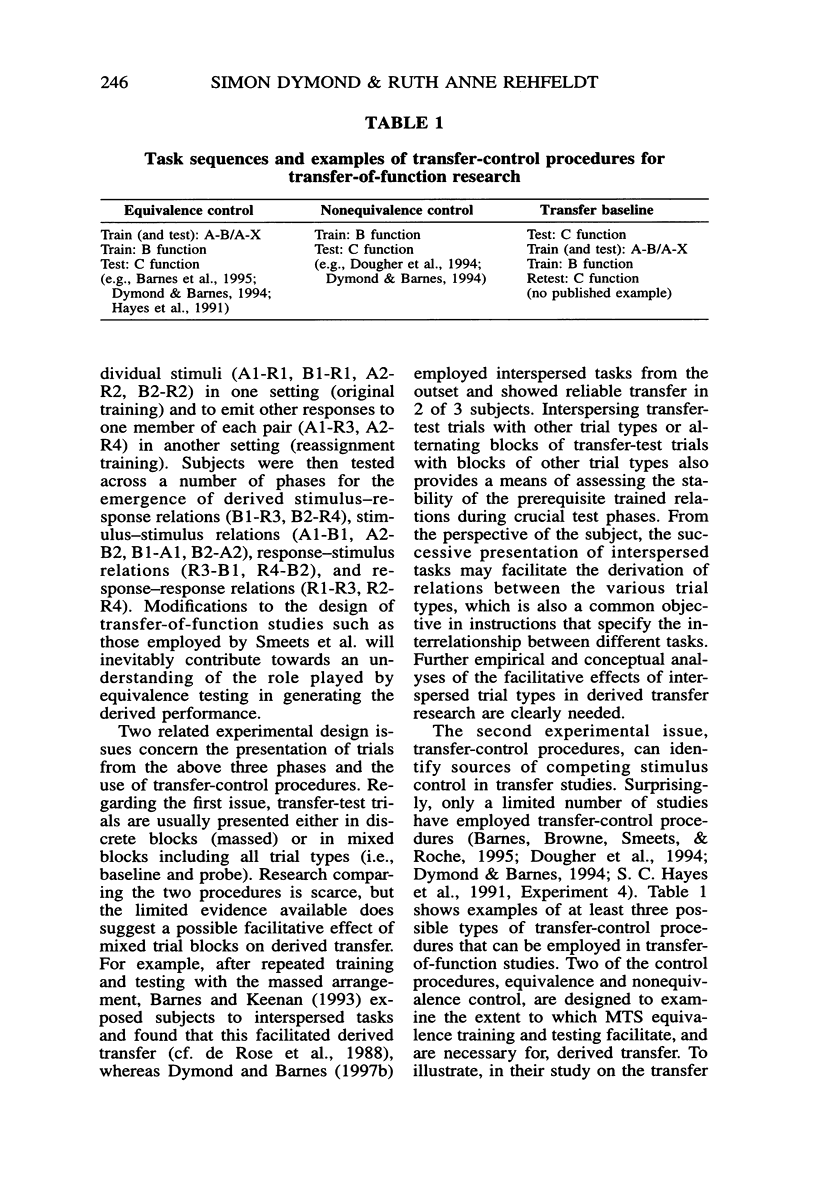
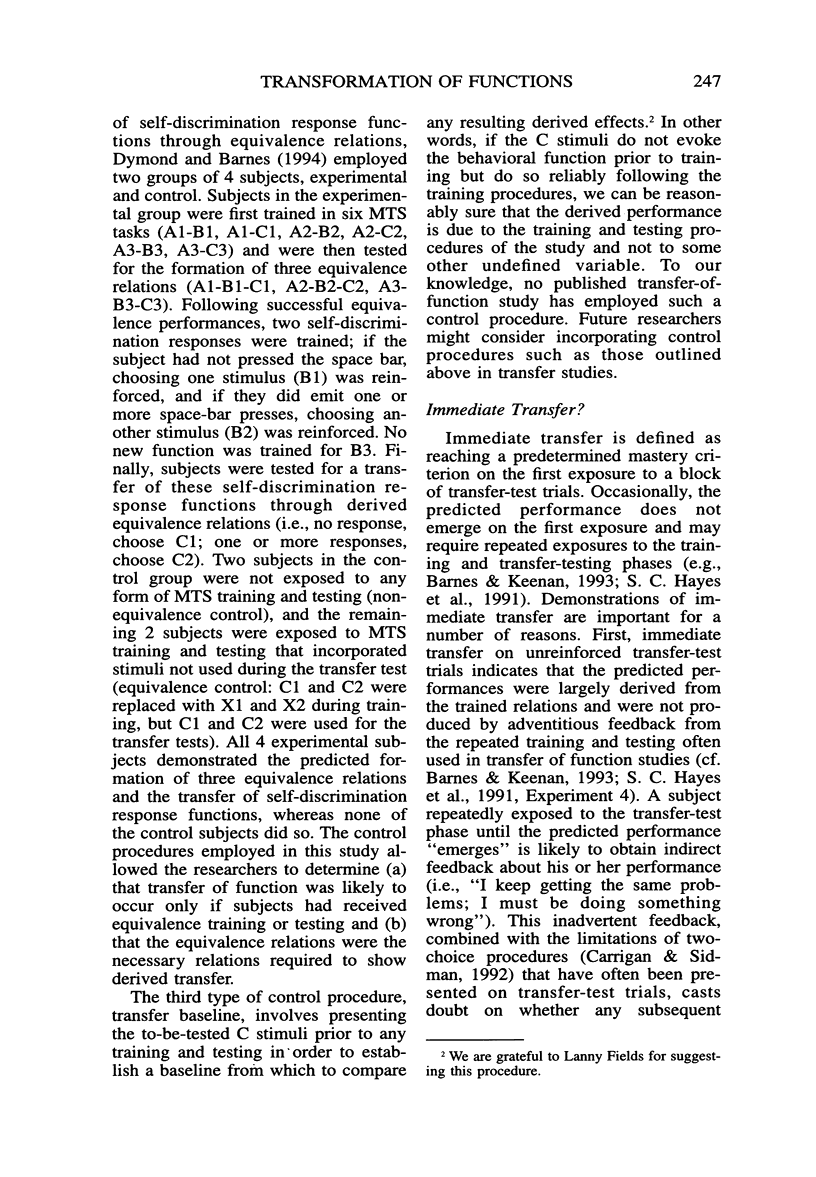
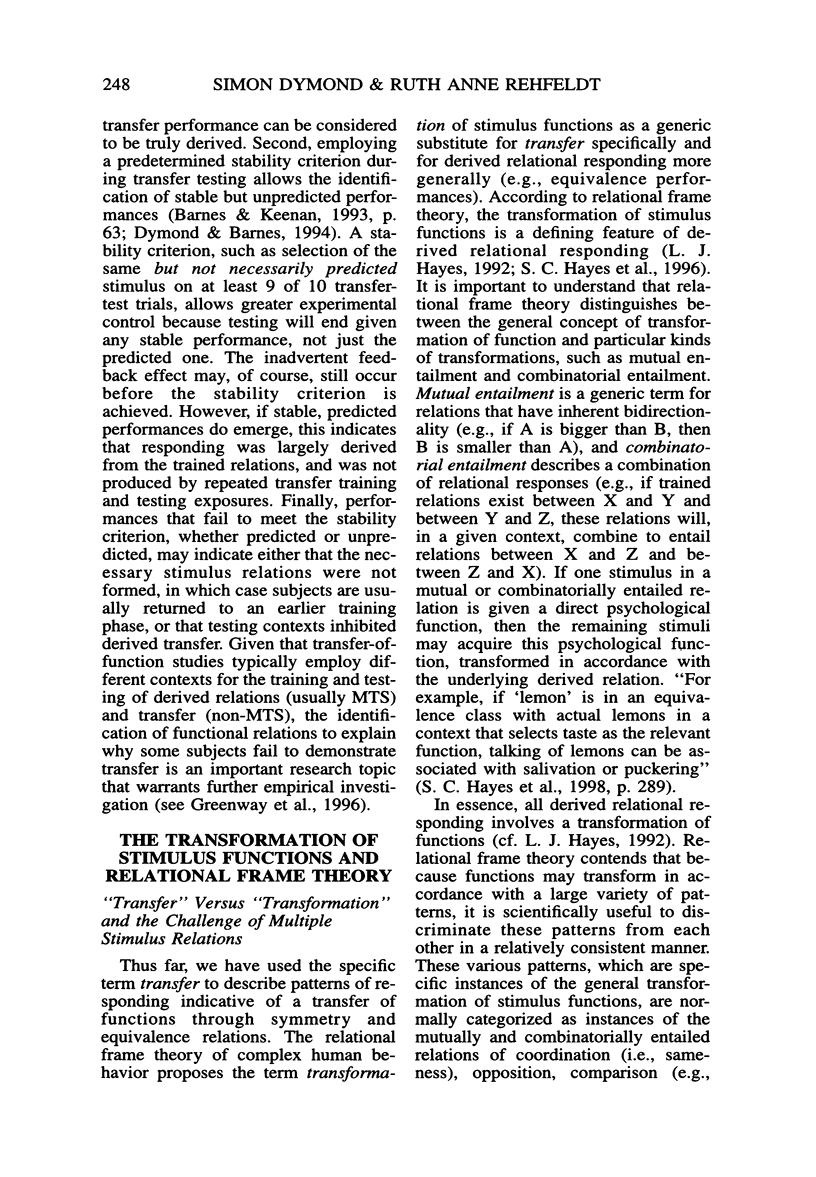
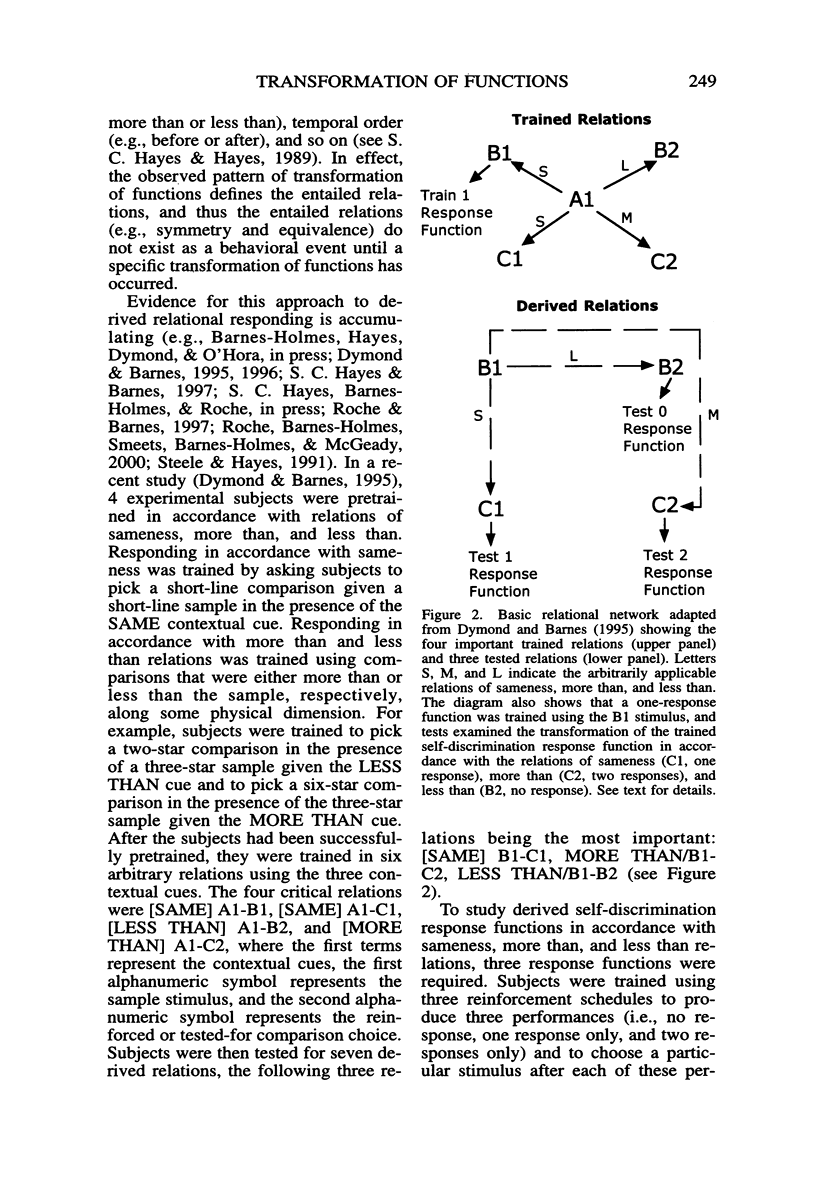
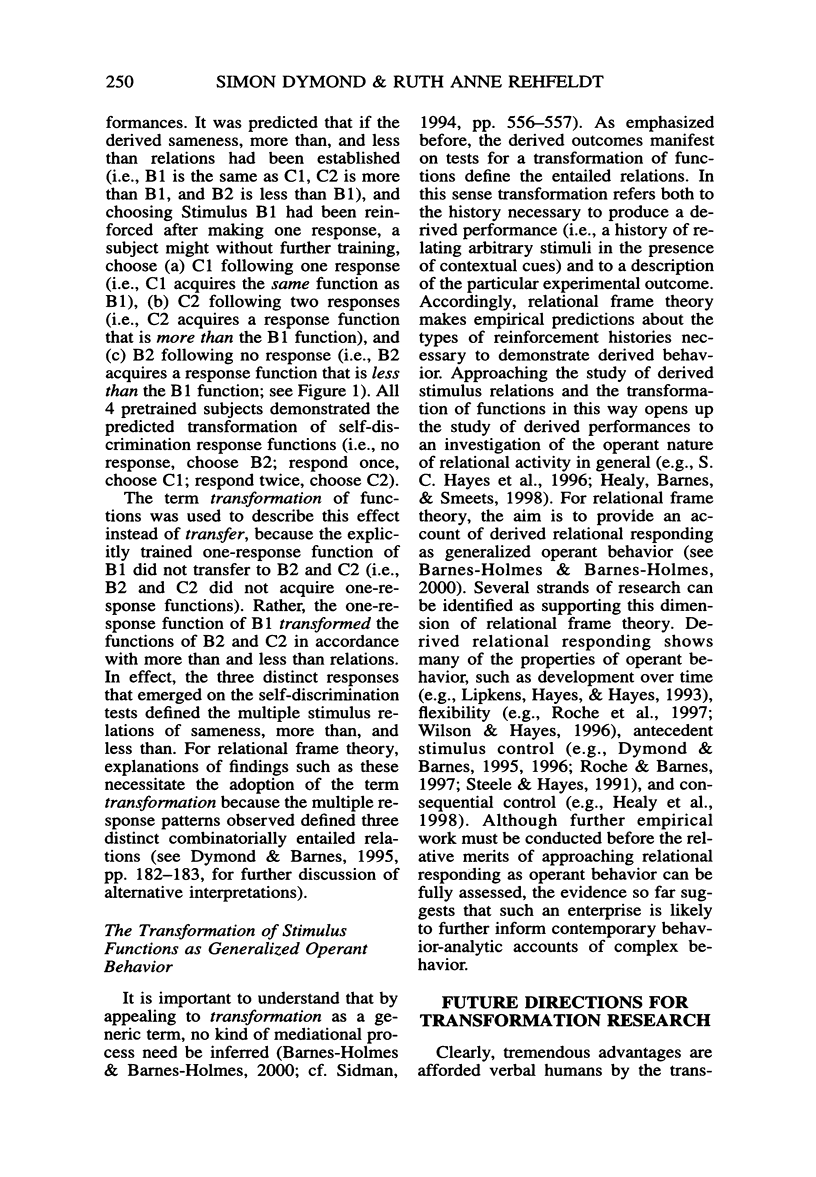
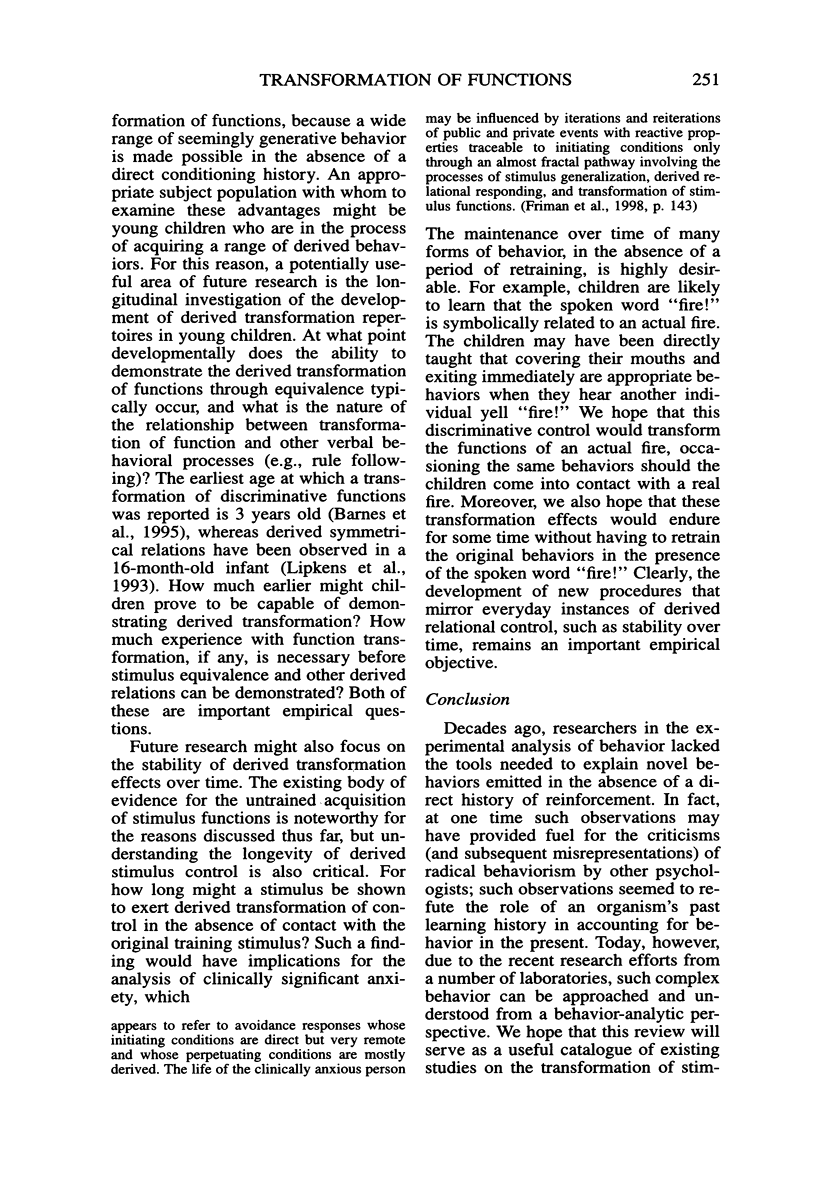
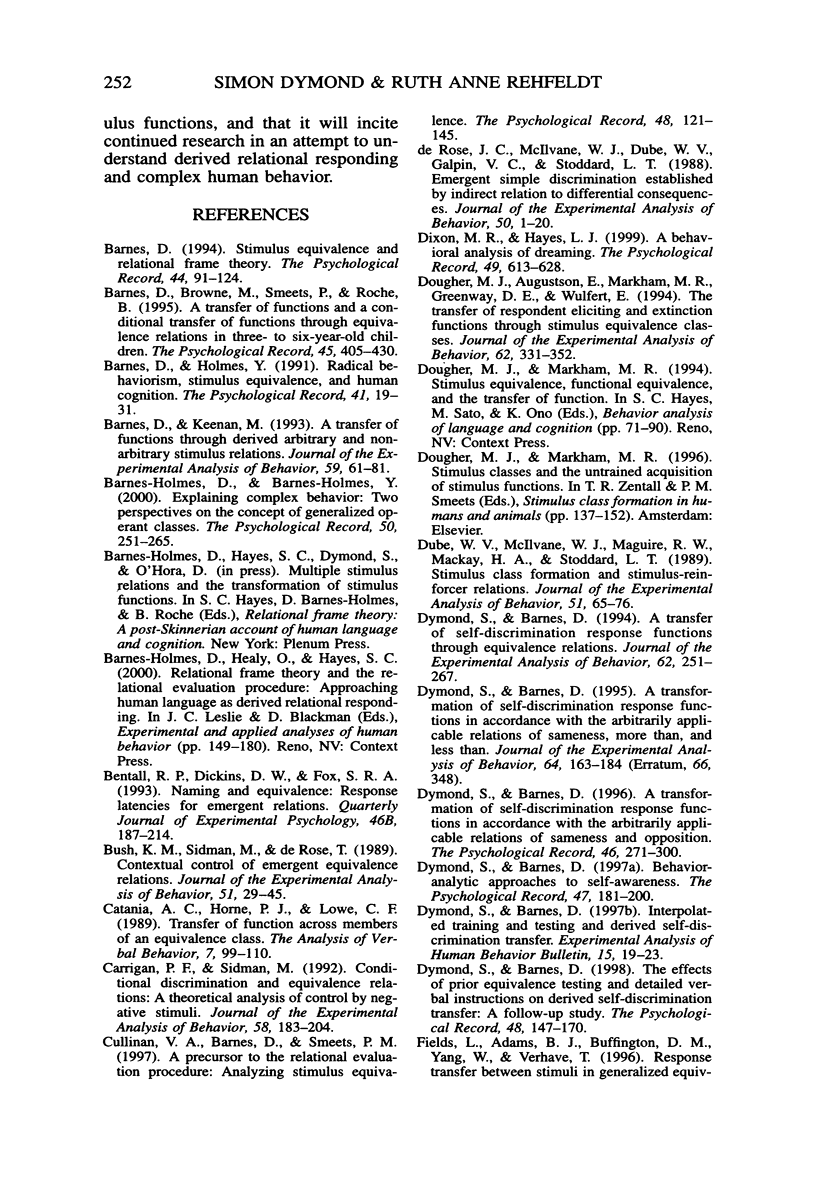
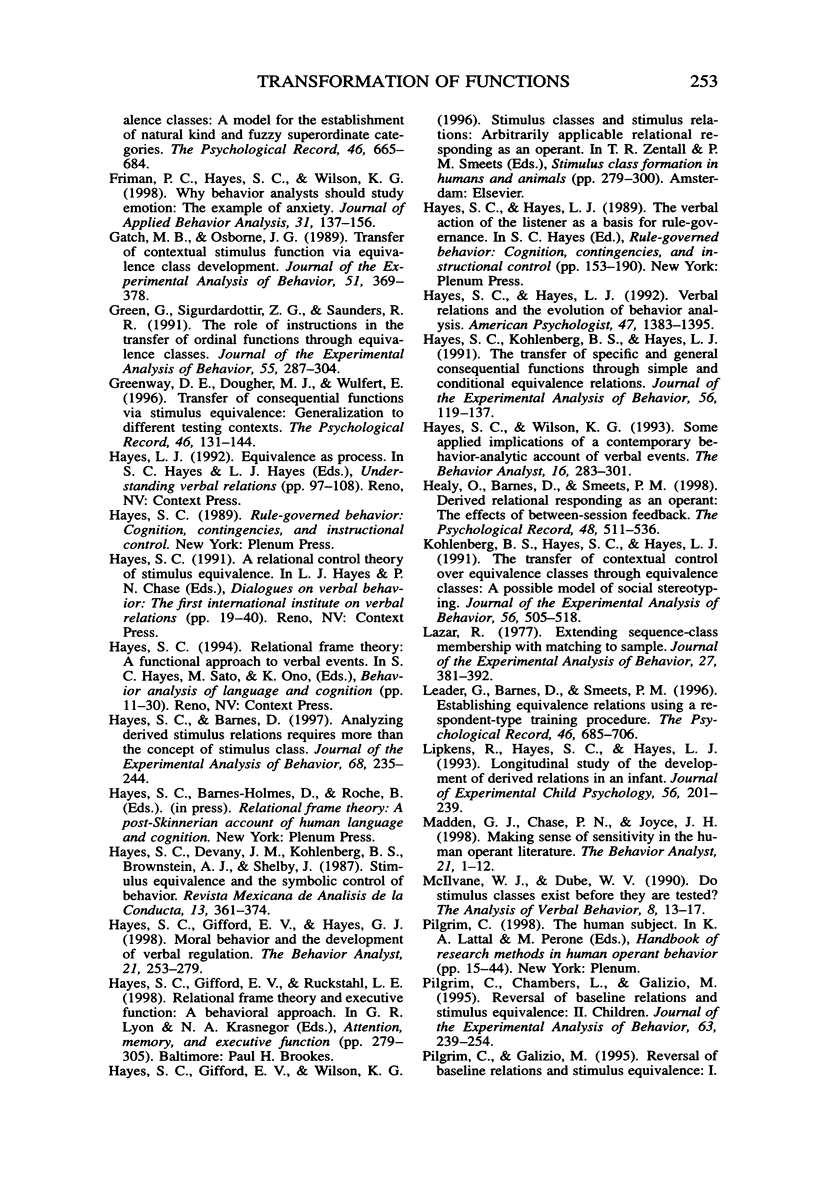

Selected References
These references are in PubMed. This may not be the complete list of references from this article.
- Barnes D., Keenan M. A transfer of functions through derived arbitrary and nonarbitrary stimulus relations. J Exp Anal Behav. 1993 Jan;59(1):61–81. doi: 10.1901/jeab.1993.59-61. [DOI] [PMC free article] [PubMed] [Google Scholar]
- Bush K. M., Sidman M., de Rose T. Contextual control of emergent equivalence relations. J Exp Anal Behav. 1989 Jan;51(1):29–45. doi: 10.1901/jeab.1989.51-29. [DOI] [PMC free article] [PubMed] [Google Scholar]
- Carrigan P. F., Sidman M. Conditional discrimination and equivalence relations: A theoretical analysis of control by negative stimuli. J Exp Anal Behav. 1992 Jul;58(1):183–204. doi: 10.1901/jeab.1992.58-183. [DOI] [PMC free article] [PubMed] [Google Scholar]
- Dougher M. J., Augustson E., Markham M. R., Greenway D. E., Wulfert E. The transfer of respondent eliciting and extinction functions through stimulus equivalence classes. J Exp Anal Behav. 1994 Nov;62(3):331–351. doi: 10.1901/jeab.1994.62-331. [DOI] [PMC free article] [PubMed] [Google Scholar]
- Dube W. V., McIlvane W. J., Maguire R. W., Mackay H. A., Stoddard L. T. Stimulus class formation and stimulus-reinforcer relations. J Exp Anal Behav. 1989 Jan;51(1):65–76. doi: 10.1901/jeab.1989.51-65. [DOI] [PMC free article] [PubMed] [Google Scholar]
- Dymond S., Barnes D. A transfer of self-discrimination response functions through equivalence relations. J Exp Anal Behav. 1994 Sep;62(2):251–267. doi: 10.1901/jeab.1994.62-251. [DOI] [PMC free article] [PubMed] [Google Scholar]
- Dymond S., Barnes D. A transformation of self-discrimination response functions in accordance with the arbitrarily applicable relations of sameness, more than, and less than. J Exp Anal Behav. 1995 Sep;64(2):163–184. doi: 10.1901/jeab.1995.64-163. [DOI] [PMC free article] [PubMed] [Google Scholar]
- Friman P. C., Hayes S. C., Wilson K. G. Why behavior analysts should study emotion: the example of anxiety. J Appl Behav Anal. 1998 Spring;31(1):137–156. doi: 10.1901/jaba.1998.31-137. [DOI] [PMC free article] [PubMed] [Google Scholar]
- Gatch M. B., Osborne J. G. Transfer of contextual stimulus function via equivalence class development. J Exp Anal Behav. 1989 May;51(3):369–378. doi: 10.1901/jeab.1989.51-369. [DOI] [PMC free article] [PubMed] [Google Scholar]
- Green G., Sigurdardottir Z. G., Saunders R. R. The role of instructions in the transfer of ordinal functions through equivalence classes. J Exp Anal Behav. 1991 May;55(3):287–304. doi: 10.1901/jeab.1991.55-287. [DOI] [PMC free article] [PubMed] [Google Scholar]
- Hayes S. C., Gifford E. V., Hayes G. J. Moral behavior and the development of verbal regulation. Behav Anal. 1998 Fall;21(2):253–279. doi: 10.1007/BF03391967. [DOI] [PMC free article] [PubMed] [Google Scholar]
- Hayes S. C., Kohlenberg B. S., Hayes L. J. The transfer of specific and general consequential functions through simple and conditional equivalence relations. J Exp Anal Behav. 1991 Jul;56(1):119–137. doi: 10.1901/jeab.1991.56-119. [DOI] [PMC free article] [PubMed] [Google Scholar]
- Hayes S. C., Wilson K. G. Some applied implications of a contemporary behavior-analytic account of verbal events. Behav Anal. 1993 Fall;16(2):283–301. doi: 10.1007/BF03392637. [DOI] [PMC free article] [PubMed] [Google Scholar]
- Hayes S., Barnes D. Analyzing derived stimulus relations requires more than the concept of stimulus class. J Exp Anal Behav. 1997 Sep;68(2):235–244. doi: 10.1901/jeab.1997.68-235. [DOI] [PMC free article] [PubMed] [Google Scholar]
- Kohlenberg B. S., Hayes S. C., Hayes L. J. The transfer of contextual control over equivalence classes through equivalence classes: a possible model of social stereotyping. J Exp Anal Behav. 1991 Nov;56(3):505–518. doi: 10.1901/jeab.1991.56-505. [DOI] [PMC free article] [PubMed] [Google Scholar]
- Lazar R. Extending sequence-class membership with matching to sample. J Exp Anal Behav. 1977 Mar;27(2):381–392. doi: 10.1901/jeab.1977.27-381. [DOI] [PMC free article] [PubMed] [Google Scholar]
- Lipkens R., Hayes S. C., Hayes L. J. Longitudinal study of the development of derived relations in an infant. J Exp Child Psychol. 1993 Oct;56(2):201–239. doi: 10.1006/jecp.1993.1032. [DOI] [PubMed] [Google Scholar]
- Madden G. J., Chase P. N., Joyce J. H. Making sense of sensitivity in the human operant literature. Behav Anal. 1998 Spring;21(1):1–12. doi: 10.1007/BF03392775. [DOI] [PMC free article] [PubMed] [Google Scholar]
- Pilgrim C., Chambers L., Galizio M. Reversal of baseline relations and stimulus equivalence: II. Children. J Exp Anal Behav. 1995 May;63(3):239–254. doi: 10.1901/jeab.1995.63-239. [DOI] [PMC free article] [PubMed] [Google Scholar]
- Pilgrim C., Galizio M. Reversal of baseline relations and stimulus equivalence: I. Adults. J Exp Anal Behav. 1995 May;63(3):225–238. doi: 10.1901/jeab.1995.63-225. [DOI] [PMC free article] [PubMed] [Google Scholar]
- Roche B., Barnes D. A transformation of respondently conditioned stimulus function in accordance with arbitrarily applicable relations. J Exp Anal Behav. 1997 May;67(3):275–301. doi: 10.1901/jeab.1997.67-275. [DOI] [PMC free article] [PubMed] [Google Scholar]
- Roche B., Barnes D., Smeets P. Incongruous stimulus pairing and conditional discrimination training: effects on relational responding. J Exp Anal Behav. 1997 Sep;68(2):143–160. doi: 10.1901/jeab.1997.68-143. [DOI] [PMC free article] [PubMed] [Google Scholar]
- Saunders R. R., Drake K. M., Spradlin J. E. Equivalence class establishment, expansion, and modification in preschool children. J Exp Anal Behav. 1999 Mar;71(2):195–214. doi: 10.1901/jeab.1999.71-195. [DOI] [PMC free article] [PubMed] [Google Scholar]
- Sidman M., Tailby W. Conditional discrimination vs. matching to sample: an expansion of the testing paradigm. J Exp Anal Behav. 1982 Jan;37(1):5–22. doi: 10.1901/jeab.1982.37-5. [DOI] [PMC free article] [PubMed] [Google Scholar]
- Sigurdardottir Z. G., Green G., Saunders R. R. Equivalence classes generated by sequence training. J Exp Anal Behav. 1990 Jan;53(1):47–63. doi: 10.1901/jeab.1990.53-47. [DOI] [PMC free article] [PubMed] [Google Scholar]
- Smeets P. M., Barnes D., Roche B. Functional equivalence in children: derived stimulus-response and stimulus-stimulus relations. J Exp Child Psychol. 1997 Jul;66(1):1–17. doi: 10.1006/jecp.1997.2378. [DOI] [PubMed] [Google Scholar]
- Spencer T. J., Chase P. N. Speed analyses of stimulus equivalence. J Exp Anal Behav. 1996 May;65(3):643–659. doi: 10.1901/jeab.1996.65-643. [DOI] [PMC free article] [PubMed] [Google Scholar]
- Steele D., Hayes S. C. Stimulus equivalence and arbitrarily applicable relational responding. J Exp Anal Behav. 1991 Nov;56(3):519–555. doi: 10.1901/jeab.1991.56-519. [DOI] [PMC free article] [PubMed] [Google Scholar]
- Wilson K. G., Hayes S. C. Resurgence of derived stimulus relations. J Exp Anal Behav. 1996 Nov;66(3):267–281. doi: 10.1901/jeab.1996.66-267. [DOI] [PMC free article] [PubMed] [Google Scholar]
- Wulfert E., Dougher M. J., Greenway D. E. Protocol analysis of the correspondence of verbal behavior and equivalence class formation. J Exp Anal Behav. 1991 Nov;56(3):489–504. doi: 10.1901/jeab.1991.56-489. [DOI] [PMC free article] [PubMed] [Google Scholar]
- Wulfert E., Hayes S. C. Transfer of a conditional ordering response through conditional equivalence classes. J Exp Anal Behav. 1988 Sep;50(2):125–144. doi: 10.1901/jeab.1988.50-125. [DOI] [PMC free article] [PubMed] [Google Scholar]
- de Rose J. C., McIlvane W. J., Dube W. V., Galpin V. C., Stoddard L. T. Emergent simple discrimination established by indirect relation to differential consequences. J Exp Anal Behav. 1988 Jul;50(1):1–20. doi: 10.1901/jeab.1988.50-1. [DOI] [PMC free article] [PubMed] [Google Scholar]


